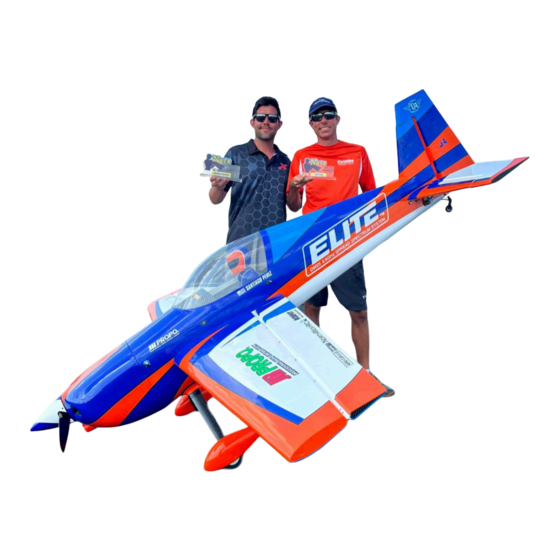
Advertisement
Quick Links
Advertisement

Summary of Contents for Extreme Flight RC Edge 540
- Page 1 120cc Build Guide 120cc Build Guide...
- Page 2 ALL liability for the use of this product, please return it to the place of purchase immediately. Extreme Flight RC guarantees this kit to be free of defects in materials and workmanship for a period of 30 DAYS from the date of purchase. All warranty claims must be accompanied by the original dated receipt. This warranty is extended to the original purchaser of the aircraft kit only.
- Page 3 This assembly guide covers the entire series of 120cc aerobatic monoplanes. They all assemble in fundamentally the same way. There are detail differences between the aircraft, but they are slight in terms of assembly. Because these are large aircraft and can be difficult to move around, we will begin with assembly of the landing gear so that the aircraft will be up on its wheels for later steps.
- Page 4 The axle system includes a wheel-pant-saver mechanism. Begin by attaching the axles to the landing gear with washers and self-locking nuts, find the flat spot on the outboard end of the axle and orient this flat spot *down* to face the runway. Assemble the “pant saver” as shown and install the wheels as shown with the pant saver as the outboard wheel retainer.
- Page 5 Using loctite, start the screws which hold the wheelpant into the landing gear, but leave them loose. Please a dab of epoxy glue between the wooden pad of the “pant saver” and the wheelpant. Tighten the screws holding the wheelpant to the landing gear.
- Page 6 Locate the tailwheel, screws, and tiller keepter (nylon ball link). Glue the keeper into the hole in the bottom of the rudder with epoxy. Install the tailwheel onto the fuse using the screws and blue loctite threadlocker. Put the plane up on its landing gear.
- Page 7 All the control horns on the aircraft install in the same way, in this step we will install the elevator and rudder horns ONLY. Scuff the gluing surface of the horns using 80-240 grit sandpaper. Assem- ble the horns with their ball link as shown. Remove the covering over the slots under the cover plate as shown.
- Page 8 For the aileron horns, note that each wing has two aileron servos and two horns. To correct for the tapering thickness of the wing, and keep the linkage geometry identical between the inner and outer servos, install the TALLER horn on the OUTBOARD location. The shorter horn goes into the thicker, inboard location.
- Page 9 Servos: You MUST use a top-quality digital, high-strength metal gear servo in these 120cc aerobat- ic monoplanes to avoid flutter and have the expected level of performance. Savox SG-2290, JR8911, and MKS599 are good choices. When installing servos, install the servo screws, then remove the screws and servo and put a small drop of thin CA glue into each screw hole to harden the area, allow to cure then re-install the servo permanently.
- Page 10 Use large washers and locking nuts on your engine mounting screws. For the DA-120 and GP-123, you will need the Blazing Star DA-120 mount, availble for Extreme Flight RC. Note that these engines are slightly different in overall length, and fiberglass cowls can vary slightly in length.
- Page 11 Pictured is a typical throttle servo installation. Take care to ensure that the pushrod does not contact the motor box at any point in its travel.
- Page 12 For stock mufflers you will need to cut the cowl for the muffler exits. One easy way to do this is to make a carboard or paper template as shown and use it to mark the cowl. Use a “dremel” type grinding tool with a sanding drum or stone attachment to make these openings in the cowl.
- Page 13 If using canister mufflers or tuned pipes, we provide outlet/vent plates for the bottom of the fuselage. Remove the covering over these locations on the bottom of the fuselage and install the plates with screws, using thin CA glue to hard the screw holes as you did your servo screw holes.
- Page 14 Many of our kits include cooling baffles (cooling ducts) which install into the cowl with epoxy glue. These ducts control the flow of air into the cowl and force the ma- jority of the air to flow through the cooling fins of the cylinder heads. If cooling air is managed, and forced to flow though the fins, it may surprise you how little flow is actually needed to cool a well-tuned model aircraft engine.
- Page 15 Here are typical equipment installation locations for this series of aircraft. For your maiden, you may wish to place your Rx batteries alongside your fuel tank. For the Extra 300, Extra NG, Slick, Extra 260 and Edge airframes, we prefer the batteries alongside the receiver for aerobatic flight.
- Page 16 Recommended control settings are as follows: Aileron Low: 20 deg up, 20 deg down 18-20% exponential High: 38 deg up, 37 deg down 50-60% exponential Elevator Low: 10-12 deg 18-20% exponential High/3D: 45-50 deg 50-60% exponential XA/Tumbling: 60+ deg 60-70% exponential Rudder Low: 20 deg 50-60% exponential High:...






Need help?
Do you have a question about the Edge 540 and is the answer not in the manual?
Questions and answers